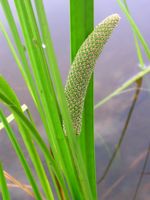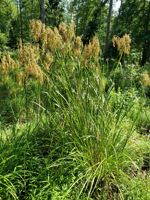Mon-Fri 9am - 5pm Mountain time
American Sweet Flag vs Woolgrass
Acorus americanus
Scirpus cyperinus
CUSTOM GROW
CUSTOM GROW
American Sweet Flag is a native perennial wetland plant found along shorelines, streams, wet meadows, and marshes. Its extensive rhizome system allows it to spread and stabilise soil, helping maintain the edges of ponds and streams. This dense growth provides cover for small animals and supports overall wetland biodiversity, while the rhizomes and seeds serve as food for small mammals and waterfowl. Cold-hardy and resilient, it is well-suited for ecological restoration, riparian plantings, erosion control, and naturalization projects.
The plant grows in dense clumps with tall, sword-shaped leaves that release a citrus-like scent when bruised. The rhizomes are aromatic, with a spicy, cinnamon-like fragrance that has been used in perfumery and flavouring. In early summer, American Sweet Flag produces a distinctive floral spike (spadix), adding visual interest to wetland plantings.
Woolgrass is a native perennial sedge that forms dense clumps in wetlands, ditches, and along shorelines. Its ability to thrive in saturated soils and shallow water, combined with its spreading growth habit, makes it especially valuable for waterside & riparian plantings, erosion control, ecological restoration, and naturalization projects.
The distinctive spikelets are covered in brown woolly bristles, which is where it gets the name Woolgrass. It produces seeds that are eaten by waterfowl and small mammals, while its dense stems offer cover and nesting habitat. It grows most actively in spring and fall, slowing or going dormant in the summer heat.

